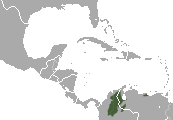Brown spider monkey
| Brown spider monkey[1] | |
|---|---|

| |
| Brown spider monkey at Barquisimeto Zoo, Venezuela | |
| Scientific classification | |
| Domain: | Eukaryota |
| Kingdom: | Animalia |
| Phylum: | Chordata |
| Class: | Mammalia |
| Order: | Primates |
| Suborder: | Haplorhini |
| Infraorder: | Simiiformes |
| Family: | Atelidae |
| Genus: | Ateles |
| Species: | A. hybridus
|
| Binomial name | |
| Ateles hybridus I. Geoffroy, 1829
| |

| |
| Brown spider monkey range in green | |
The brown spider monkey or variegated spider monkey (Ateles hybridus) is a
Like all spider monkeys, it has long, slender limbs and a long prehensile tail. The brown spider monkey has a whitish belly and patch on the forehead, and – highly unusual among spider monkeys – its eyes can be pale blue.
The brown spider monkey is one of the most threatened primates in the Neotropics and has been listed six times on The World's 25 Most Endangered Primates.
Taxonomy
Some scientists recognize two subspecies, Ateles hybridus hybridus, found in both Colombia and Venezuela and Ateles hybridus brunneus, found between Cauca and Magdalena River in Colombia.[1] Molecular studies have not supported the subspecies designations and treat the species as a single taxon.[3][2]
Physical description
The brown spider monkey has long and thin limbs with longer forelimbs than hind limbs. It has a distinctive 75 cm (30 in) long flexible, thin and prehensile tail which at times acts like a fifth limb. The tail has a highly flexible, hairless tip with skin grooves which improves grip. Brown spider monkeys have four curved fingers and lack thumbs to help them swing from one tree to another.[4] These features make it possible for it to climb trees at high elevations, and hang and swing from one tree to another without often having to return to the ground. Adult males weigh between 7.9 and 9.1 kg (17 and 20 lb) and adult females weigh between 7.5 and 9 kg (17 and 20 lb). Its average adult body length is about 35 to 70 cm (14 to 28 in).[5] Its coloration ranges from light brown to dark on upper parts including the head. Its most distinctive characteristic is a whitish triangular forehead patch, although not all individuals have one. Some have pale blue eyes but most are brown.[6][7] Typically, the brown spider monkeys live between 10 and 27 years, but average about 22 years in the wild.[5]
Distribution
The brown spider monkey is found in northern
The inter-Andean forest is also diminishing due to mining, infrastructure, and other industrial reinforcements.[8] In addition, their recovery from population loss is due to their low reproductive rate. Typically, they reproduce every 2–3 years.[9]
Ecology and behaviour

Even though the brown spider monkey spends most of its time high in trees, it occasionally descends to
The brown spider monkey mainly forages in the forest canopy and relies mostly on its senses of sight, smell, taste, and touch to find food. It is mainly
The fragmented lands that brown spider monkeys live in, causes their social behavior and ranging patterns to vary. The male-to-female aggression is very common and a consistent pattern, as it is a mechanism of social control for an indirect form of sexual coercion or a ritualized courtship. [10]
Average lifespan of a spider monkey is 27 years, however, in captivity it can reach 40 years old.[6]
Natural predators include
Conservation
Since 2004, the brown spider monkeys have been listed as one of the most endangered primates in Colombia's inter-Andean Valleys. This is due to habitat fragmentation, threats of hunting, and threats of capture for pet trade.
Conservation efforts such as alleviating the detrimental effects of fragmented landscapes on the brown spider monkey population are being pursued. Corridors are being utilized to direct the brown spider monkeys back to their natural habitat that has been severely fragmented.[15] A recent study performed in Central Colombia found that 21 out of 32 vertebrate species have used corridors that connect them to landscapes that have been fragmented.[15]
The IUCN is a group that is aiming to protect and grow the spider monkey population. They are raising money to help create corridors that connect them to all of the fragmented land. They are also aiming to educate the local human population that live amongst the spider monkeys to try and raise awareness and request more help.[16]
A small population of fewer than 30 individuals has been discovered in a protected area of Colombia, the Selva de Florencia National Natural Park. This is the southernmost population of the brown spider monkey.[17] Brown spider monkeys are also known from other reserves in both Colombia and Venezuela.[2] Currently there are about 3,000 brown spider monkeys left in the between the forests in Columbia and Venezuela.[5]
References
- ^ OCLC 62265494.
- ^ . Retrieved 19 November 2021.
- S2CID 17621468.
- ^ Ann Eddens. "Brown Spider Monkey Specifics". Study.com. Retrieved 2023-04-25.
- ^ a b c "Brown Spider Monkey – Endangered Wildlife". Retrieved 2023-04-25.
- ^ a b c d e f Thunstrom, Maria (2009). "Ateles hybridus brown spider monkey". Animal Diversity Web. Retrieved 17 September 2021.
- ISBN 0-226-20719-6.
- ^ .
- ISSN 1573-8604.
- .
- ^ ISBN 978-1-934151-34-1. Archived from the original(PDF) on 2011-07-23.
- International Species Information System. 2010. Archived from the originalon 2010-07-06. Retrieved 21 May 2010.
- ^ "Tragic demise of the Magdalena spider monkey". Fundación ProAves. 2010. Retrieved 21 May 2010.
- S2CID 83628317.
- ^ ISSN 1061-2971.
- ^ "Protecting the Critically Endangered Brown Spider Monkey". IUCN NL. Retrieved 2023-03-29.
- ^ Dell'Amore, Christine (27 January 2012). "Near-extinct monkeys found in Colombian Park". National Geographic. Archived from the original on January 30, 2012. Retrieved 9 January 2012.

